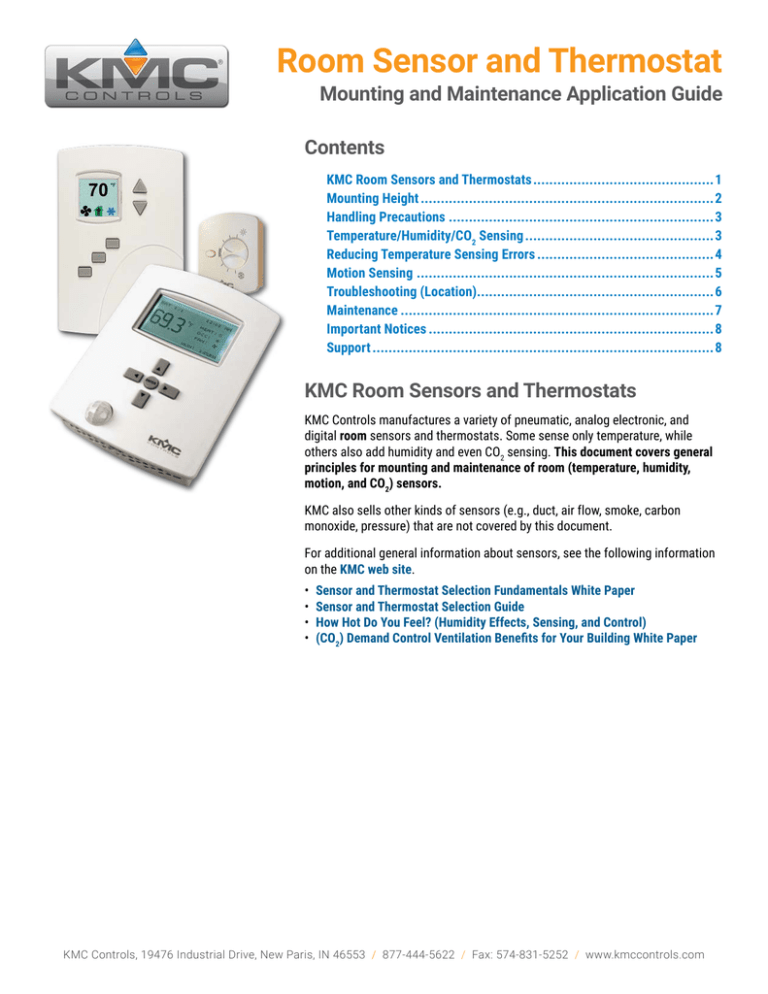
Room Sensor and Thermostat
Mounting and Maintenance Application Guide
Contents
KMC Room Sensors and Thermostats..............................................1
Mounting Height..........................................................................2
Handling Precautions...................................................................3
Temperature/Humidity/CO2 Sensing................................................3
Reducing Temperature Sensing Errors.............................................4
Motion Sensing...........................................................................5
Troubleshooting (Location)............................................................6
Maintenance...............................................................................7
Important Notices........................................................................8
Support......................................................................................8
KMC Room Sensors and Thermostats
KMC Controls manufactures a variety of pneumatic, analog electronic, and
digital room sensors and thermostats. Some sense only temperature, while
others also add humidity and even CO2 sensing. This document covers general
principles for mounting and maintenance of room (temperature, humidity,
motion, and CO2) sensors.
KMC also sells other kinds of sensors (e.g., duct, air flow, smoke, carbon
monoxide, pressure) that are not covered by this document.
For additional general information about sensors, see the following information
on the KMC web site.
• Sensor and Thermostat Selection Fundamentals White Paper
• Sensor and Thermostat Selection Guide
• How Hot Do You Feel? (Humidity Effects, Sensing, and Control)
• (CO2) Demand Control Ventilation Benefits for Your Building White Paper
KMC Controls, 19476 Industrial Drive, New Paris, IN 46553 / 877-444-5622 / Fax: 574-831-5252 / www.kmccontrols.com
Mounting Height
Traditionally, thermostats and room temperature sensors have been mounted
approximately 60 inches (152 cm) from the floor. This has been considered
an effective height to measure the room temperature and to allow a person to
adjust a setpoint while standing.
However, for thermostats (and sensors with adjustable setpoint controls), the
Americans with Disabilities Act (ADA) has rules to ensure that public lodging
spaces and facilities remain accessible to the disabled. (They do not apply
to private homes that rent fewer than five rooms.) To ensure that people in
wheelchairs can reach and adjust the setpoint without assistance, ADA rules
specify thermostat placement to be no higher than 48 inches (121 cm) above the
floor (assuming no other obstructions are below it).
BEFORE running conduit and installing a thermostat, check the specific details
of any applicable compliance requirements!
Sealant
Plugging
Conduit
and
Other
Holes
Optional Insulating Gasket
Backplate
Cover
Electrical
Box
Approximately
60 Inches
(Traditional)
48 Inches
Max. (ADA)
Mounting Components and Height
2AG150119C
Handling Precautions
For digital and electronic sensors, thermostats, and controllers, take reasonable
precautions to prevent electrostatic discharges to the devices when installing,
servicing, or operating them. Discharge accumulated static electricity by
touching one’s hand to a securely grounded object before working with each
device.
Temperature/Humidity/CO2 Sensing
For effective sensing, the thermostat or sensor must be mounted in a location
enabling it to sense the general room environment. It must NOT be:
• Mounted on an exterior wall. See Reducing Temperature Sensing Errors on
page 4.
• Mounted on or near a large thermal mass (e.g., concrete block wall). See
Reducing Temperature Sensing Errors on page 4.
• Blocked from normal air circulation by obstructions.
• Exposed to heat sources (e.g., lights, computers, copiers, or coffee makers) or
to sunlight (at any time of the day).
• Exposed to drafts from windows, doorways, diffusers, or returns.
• Exposed to air flow through the conduit (e.g., from leaks in plenum ducts) or
other holes into the wall cavity. See Reducing Temperature Sensing Errors on
page 4.
The above factors primarily affect temperature sensing, but they may also affect
accurate humidity and CO2 sensing as well.
AG150119C3
Reducing Temperature Sensing Errors
• Air movement between the conditioned space and the conduit and/or wall cavity can skew sensor readings. Apply sealant inside the conduit and other holes
to block air leakage. See Mounting Components and Height on page 2.
• Mounting on an exterior wall will allow varying outside conditions to affect
the sensor’s readings. Mounting on or near a large interior thermal mass (e.g.,
concrete block wall) can slow the sensor’s response to room air temperature
changes. These mounting areas should be avoided, but a foam gasket (e.g.,
HPO-1161 or HPO-9002) mounted behind the backplate may help insulate the
sensor from a less-than-optimal wall surface. See (HPO-9002) Foam Gasket
on (AppStat) Backplate on page 4, Mounting Components and Height on page
2, and the accessories available for the applicable product.
NOTE: A foam gasket may also help block air leakage from the wall cavity.
(HPO-9002) Foam Gasket on (AppStat) Backplate
• After the sensor has been operating for at least 30 minutes, calibrate the controller input or thermostat for maximum accuracy within its environment. See
the relevant product calibration procedure to provide the optimal offset.
4AG150119C
Motion Sensing
For motion sensing models, mount the sensor on a wall that will have an
unobstructed view of the typical traffic in the coverage area. When choosing a
location, the sensor must NOT be:
• Behind curtains or other obstructions.
• In locations exposed to direct sunlight or heat sources.
• Near a heating or cooling inlet or outlet.
To BAS
Integrated
Motion and
Temp.
Sensor
Obstruction
Motion Sensor
Typical Motion Sensing Coverage
Situations that would need additional remote motion sensors (third party,
purchased separately) to be connected to the controller include:
• Areas with obstructions that block sensor coverage.
• Areas too large for adequate coverage by the sensor/thermostat’s single builtin sensor.
NOTE: Using remote sensors requires custom programming in controllers. For
more information about using integrated and remote motion sensors in
a FlexStat, see the FlexStat Application Guide.
For KMC motion sensors, the effective detection range is approximately 33 feet
(10 meters). Factors that may reduce the range may include the following items.
• The difference between the surface temperature of the object and the background temperature of the room is too small.
• Object movement in a direct line toward the sensor.
• Very slow or very fast object movement.
• Obstructions in the sensing area (see Typical Motion Sensor Pattern on page
6).
False detections may be triggered by any of the following conditions.
• The temperature inside the detection range suddenly changes because of the
entry of cold or warm air from an air-conditioning or heating unit.
• The sensor being directly exposed to sunlight, an incandescent light, or other
source of far‑infrared rays.
• Small animal movement.
AG150119C5
(Side View)
(Top View)
Typical Motion Sensor Pattern
Troubleshooting (Location)
Inaccurate sensing may be caused by one of a variety of electrical or
configuration issues. See the installation and/or application guide of the sensor
for those factors.
To correct or compensate for sensing problems caused by mounting issues:
• Reposition the sensor or the surrounding obstructions.
• Insulate the sensor from air leakage and heating/cooling sources. See Mounting Components and Height on page 2 and Reducing Temperature Sensing
Errors on page 4.
• Adjust the sensor calibration to offset the environmental issues.
6AG150119C
Maintenance
For temperature and humidity sensing, remove dust as necessary from the
ventilation holes in the top and bottom of the case.
For the case or display, clean with a soft, damp cloth (and mild soap if
necessary).
To maintain maximum sensitivity of the built-in motion sensor, occasionally wipe
dust or dirt off the lens—but do not use any fluid on the sensor.
CO2 sensors designed for continuous occupation applications, such as in the
BAC-14xxxx FlexStats, require periodic calibration with gas to maintain long-term
accuracy. See the CO2 calibration section in the FlexStat Application Guide for
more information.
NOTE:BAC-13xxxx FlexStats and most other KMC CO2 sensors are designed
to operate in areas where CO2 levels periodically fall to outside levels
during unoccupied periods. Such models self-calibrate over time, and
calibrating them with gas may not be necessary or even feasible.
AG150119C7
Important Notices
The KMC logo and KMC Controls are registered trademarks of KMC Controls,
Inc. Other products and name brands mentioned may be trademarks of their
respective companies or organizations.
All rights reserved. No part of this publication may be reproduced, transmitted,
transcribed, stored in a retrieval system, or translated into any language in any
form by any means without the written permission of KMC Controls, Inc.
The material in this document is for information purposes only. The contents
and the product it describes are subject to change without notice. KMC
Controls, Inc. makes no representations or warranties with respect to this
document. In no event shall KMC Controls, Inc. be liable for any damages, direct
or incidental, arising out of or related to the use of this document.
Support
Additional resources for product specifications, installation, configuration,
application, operation, programming, upgrading and much more are available on
the KMC Controls web site (www.kmccontrols.com). To see all available files,
log-in to the KMC Partners site.
8AG150119C
© 2016 KMC Controls, Inc.
Specifications and design subject to change without notice
AG150119C



